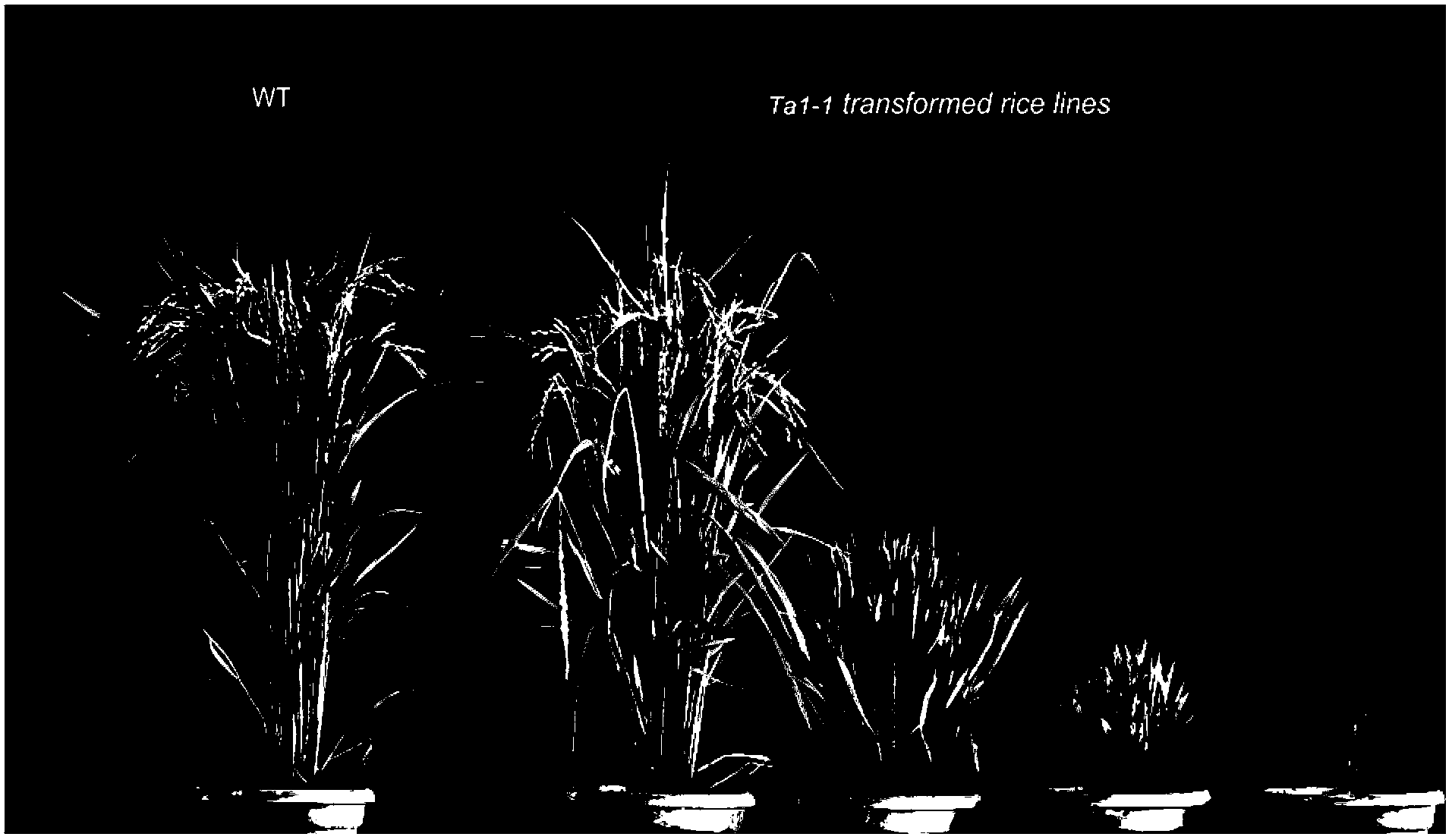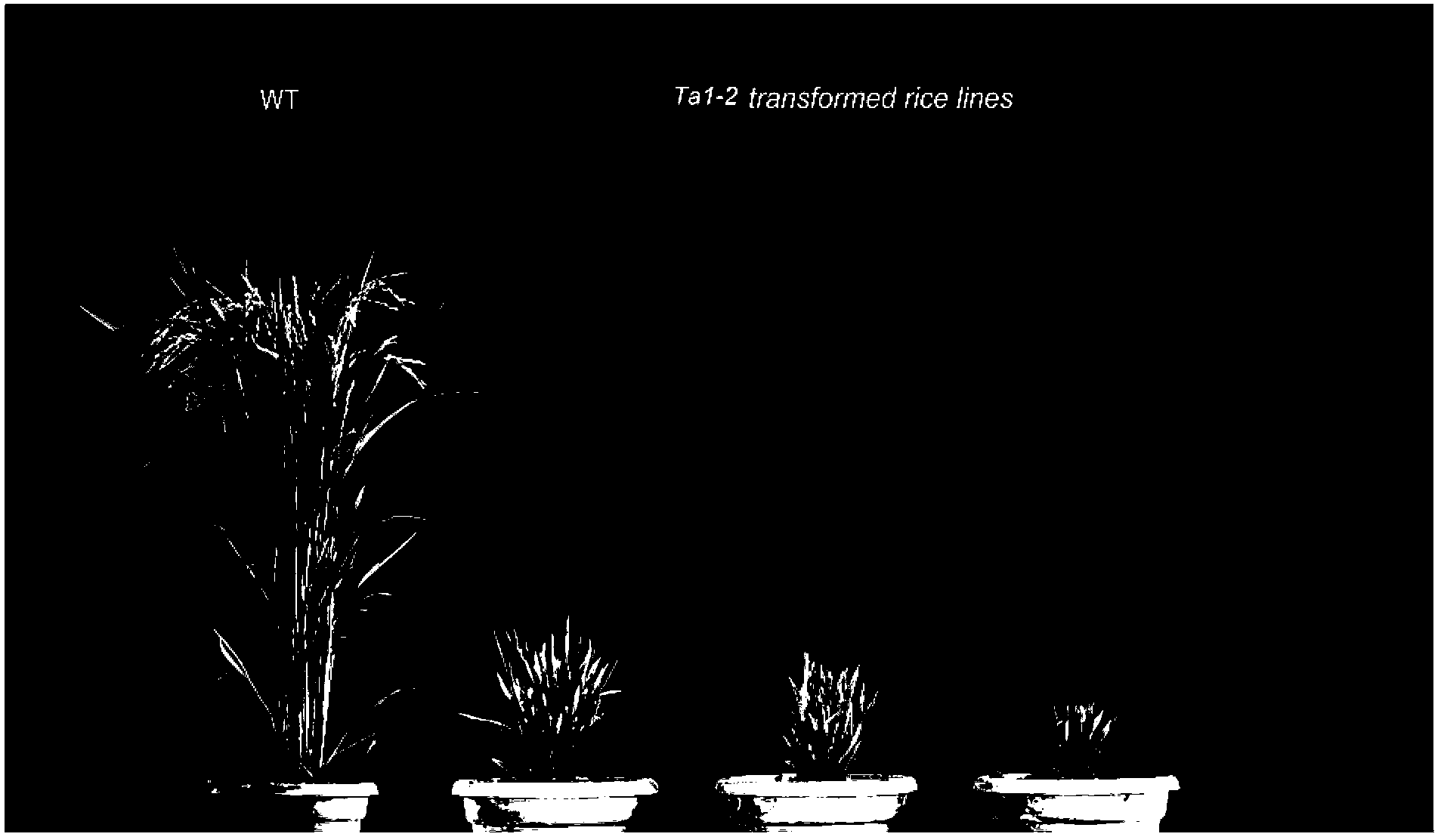Gene and polypeptide for regulating and controlling plant height of crop and application of polypeptide
A crop and gene technology, applied in the field of gene technology and botany, can solve the problems of easy lodging, high plant height, limited yield potential, etc., and achieve the effect of increasing yield and improving crop traits
- Summary
- Abstract
- Description
- Claims
- Application Information
AI Technical Summary
Problems solved by technology
Method used
Image
Examples
Embodiment 1
[0046] Identification and isolation of Ta1 in wheat
[0047] Based on a candidate gene sequence, eight clones were randomly selected and sequenced in Chinese spring wheat cultivars by PCR amplification. The length of each clone sequence in the 6 clones is at least 1530bp, and they all contain at least one base difference and a complete ORF (see sequence information SEQ ID NO.1-6). These 6 genes were further transferred into Nipponbare rice varieties to verify their specific functions.
Embodiment 2
[0049] Overexpression of Ta1 in transgenic rice
[0050] In order to verify the effect of Ta1 gene on plant growth, we constructed an overexpression vector pUN1301 containing maize ubiquitin promoter and transferred these six coding genes into rice. Based on different Ta1 gene coding sequences, a total of 6 overexpression vectors were constructed and marked as Ta1-1~6. In the transgenic rice plants successfully transformed with the vector, we can find that the Ta1-1, Ta1-2, Ta1-4, Ta1-5 and Ta1-6 gene overexpression plant series all showed a significant dwarf phenotype, But the Ta1-3 overexpression line did not show obvious phenotypic changes compared with the wild type. (See Figure 1-6 ).
[0051] Among the transgenic rice plants exhibiting abnormal phenotypes, the dwarf phenotype of Ta1-2 series transgenic rice plants was more obvious than other plants, and the plants of this series were basically difficult to reach the heading stage. In other transgenic rice plants, ph...
Embodiment 3
[0053] Ta1 gene transcription analysis
[0054] We conducted a comprehensive identification of the expression of Ta11-1~6 series genes in transgenic rice, including plants showing obvious dwarf phenotype and these transgenic plants showing no obvious difference from wild type. We identified these plants by quantitative PCR, and the results showed that these coding genes were significantly up-regulated in transgenic rice plants compared with our wild-type control, including the Ta1-3 series and in order to ensure the Ta1 gene detection The accuracy of the replicated transcriptome set (see Figure 1-12 ). Among the phenotypic comparison results of several transgenic rice series, the Ta1-3 series did not obtain an obvious dwarfing trend, but the results of quantitative PCR identification showed that the Ta1 gene was present in the three replicate controls of Ta1-3 plants we set up. The expressions were all up-regulated, and the reason for this result may be that the Ta1-3 gene ...
PUM
 Login to View More
Login to View More Abstract
Description
Claims
Application Information
 Login to View More
Login to View More - Generate Ideas
- Intellectual Property
- Life Sciences
- Materials
- Tech Scout
- Unparalleled Data Quality
- Higher Quality Content
- 60% Fewer Hallucinations
Browse by: Latest US Patents, China's latest patents, Technical Efficacy Thesaurus, Application Domain, Technology Topic, Popular Technical Reports.
© 2025 PatSnap. All rights reserved.Legal|Privacy policy|Modern Slavery Act Transparency Statement|Sitemap|About US| Contact US: help@patsnap.com



